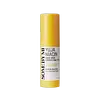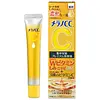What's inside
What's inside
 Key Ingredients
Key Ingredients

 Benefits
Benefits

 Concerns
Concerns

 Ingredients Side-by-side
Ingredients Side-by-side

Citrus Junos Fruit Extract 37%
Skin ConditioningButylene Glycol
HumectantBis-PEG-18 Methyl Ether Dimethyl Silane
EmollientGlycerin
HumectantNiacinamide 5%
SmoothingSodium Stearate
CleansingPentylene Glycol
Skin Conditioning1,2-Hexanediol
Skin ConditioningAllantoin
Skin ConditioningEthylhexylglycerin
Skin ConditioningMelaleuca Alternifolia Leaf Extract
PerfumingCentella Asiatica Extract
CleansingPolygonum Cuspidatum Root Extract
AntioxidantScutellaria Baicalensis Root Extract
AstringentCamellia Sinensis Leaf Extract
AntimicrobialRosmarinus Officinalis Leaf Extract
AntimicrobialGlycyrrhiza Uralensis Root Extract
Skin ConditioningChamomilla Recutita Flower Extract
MaskingBHT
AntioxidantPanthenol
Skin ConditioningArginine
MaskingGlutathione
Biotin
AntiseborrhoeicSodium Ascorbyl Phosphate
AntioxidantAscorbyl Tetraisopalmitate
AntioxidantArbutin
AntioxidantTocopheryl Acetate
AntioxidantFolic Acid
Skin ConditioningPyridoxine Hcl
Skin ConditioningGlyceryl Linoleate
EmollientMadecassoside
AntioxidantCI 19140
Cosmetic ColorantCentella Asiatica Leaf Extract
Skin ConditioningAsiaticoside
AntioxidantGlyceryl Linolenate
EmollientGlycyrrhiza Glabra Root Extract
BleachingGlyceryl Arachidonate
EmollientMadecassic Acid
Skin ConditioningAsiatic Acid
Skin ConditioningPalmitoyl Dipeptide-10
Skin ConditioningPalmitoyl Tetrapeptide-7
Skin ConditioningPalmitoyl Tripeptide-1
Skin ConditioningAscorbyl Palmitate
AntioxidantParfum
MaskingLimonene
PerfumingCitrus Junos Fruit Extract 37%, Butylene Glycol, Bis-PEG-18 Methyl Ether Dimethyl Silane, Glycerin, Niacinamide 5%, Sodium Stearate, Pentylene Glycol, 1,2-Hexanediol, Allantoin, Ethylhexylglycerin, Melaleuca Alternifolia Leaf Extract, Centella Asiatica Extract, Polygonum Cuspidatum Root Extract, Scutellaria Baicalensis Root Extract, Camellia Sinensis Leaf Extract, Rosmarinus Officinalis Leaf Extract, Glycyrrhiza Uralensis Root Extract, Chamomilla Recutita Flower Extract, BHT, Panthenol, Arginine, Glutathione, Biotin, Sodium Ascorbyl Phosphate, Ascorbyl Tetraisopalmitate, Arbutin, Tocopheryl Acetate, Folic Acid, Pyridoxine Hcl, Glyceryl Linoleate, Madecassoside, CI 19140, Centella Asiatica Leaf Extract, Asiaticoside, Glyceryl Linolenate, Glycyrrhiza Glabra Root Extract, Glyceryl Arachidonate, Madecassic Acid, Asiatic Acid, Palmitoyl Dipeptide-10, Palmitoyl Tetrapeptide-7, Palmitoyl Tripeptide-1, Ascorbyl Palmitate, Parfum, Limonene
Ascorbic Acid
AntioxidantPyridoxine Hcl
Skin ConditioningAllantoin
Skin ConditioningIsopropylparaben
Preservative2-O-Ethyl Ascorbic Acid
Skin ConditioningAscorbyl Tetraisopalmitate
AntioxidantTocopherol
AntioxidantAlpinia Oxyphylla Seed Extract
Skin ConditioningCitrus Limon Leaf Extract
PerfumingCitrus Grandis Leaf Extract
AstringentSerine
MaskingButylene Glycol
HumectantPropanediol
SolventPPG-3 Methyl Ether
SolventButane
PEG-8
HumectantRosa Centifolia Flower Extract
AstringentDecyltetradeceth-25
EmulsifyingParfum
MaskingAscorbic Acid, Pyridoxine Hcl, Allantoin, Isopropylparaben, 2-O-Ethyl Ascorbic Acid, Ascorbyl Tetraisopalmitate, Tocopherol, Alpinia Oxyphylla Seed Extract, Citrus Limon Leaf Extract, Citrus Grandis Leaf Extract, Serine, Butylene Glycol, Propanediol, PPG-3 Methyl Ether, Butane, PEG-8, Rosa Centifolia Flower Extract, Decyltetradeceth-25, Parfum
 Reviews
Reviews

Ingredients Explained
These ingredients are found in both products.
Ingredients higher up in an ingredient list are typically present in a larger amount.
Allantoin is a soothing ingredient known for its protective and moisturizingg properties. Because of this, it is often added to products with strong active ingredients.
Studies show higher concentrations of this ingredient can promote wound healing.
Though it can be derived from the comfrey plant, allantoin is produced synthetically for cosmetic products to ensure purity.
Learn more about AllantoinAscorbyl Tetraisopalmitate is a version of ascorbic acid, or Vitamin C.
This ingredient has many benefits including reducing wrinkles, skin soothing, dark spot fading, and fighting against free radicals.
It helps with dark spot fading by interfering with the process of skin darkening, helping to reduce hyperpigmentation. Like other forms of vitamin C, this ingredient encourages the skin to create more collagen.
As an antioxidant, it helps fight free-radicals. Free-radicals are molecules that may damage your skin cells.
One study found Ascorbyl Tetraisopalmitate to degrade in sunlight, but is stabilized when combined with acetyl zingerone.
Learn more about Ascorbyl TetraisopalmitateButylene Glycol (or BG) is used within cosmetic products for a few different reasons:
Overall, Butylene Glycol is a safe and well-rounded ingredient that works well with other ingredients.
Though this ingredient works well with most skin types, some people with sensitive skin may experience a reaction such as allergic rashes, closed comedones, or itchiness.
Learn more about Butylene GlycolParfum is a catch-all term for an ingredient or more that is used to give a scent to products.
Also called "fragrance", this ingredient can be a blend of hundreds of chemicals or plant oils. This means every product with "fragrance" or "parfum" in the ingredients list is a different mixture.
For instance, Habanolide is a proprietary trade name for a specific aroma chemical. When used as a fragrance ingredient in cosmetics, most aroma chemicals fall under the broad labeling category of “FRAGRANCE” or “PARFUM” according to EU and US regulations.
The term 'parfum' or 'fragrance' is not regulated in many countries. In many cases, it is up to the brand to define this term.
For instance, many brands choose to label themselves as "fragrance-free" because they are not using synthetic fragrances. However, their products may still contain ingredients such as essential oils that are considered a fragrance by INCI standards.
One example is Calendula flower extract. Calendula is an essential oil that still imparts a scent or 'fragrance'.
Depending on the blend, the ingredients in the mixture can cause allergies and sensitivities on the skin. Some ingredients that are known EU allergens include linalool and citronellol.
Parfum can also be used to mask or cover an unpleasant scent.
The bottom line is: not all fragrances/parfum/ingredients are created equally. If you are worried about fragrances, we recommend taking a closer look at an ingredient. And of course, we always recommend speaking with a professional.
Learn more about ParfumPyridoxine hydrochloride, also known as vitamin B6, has skin conditioning properties. According to a manufacturer, this ingredient is an effective anti-dandruff treatment as it reduces sebum levels and oily spots.